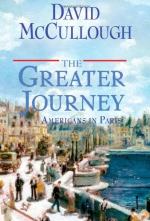
|
| Name: _________________________ | Period: ___________________ |
This test consists of 15 multiple choice questions and 5 short answer questions.
Multiple Choice Questions
1. For whose release did Washburne fight for in April of 1871?
(a) Monseigneur Georges Darboy.
(b) Augustus Saint-Gaudens.
(c) George Healy.
(d) Raoul Rigault.
2. Who was Stanford White?
(a) A writer.
(b) An architect.
(c) A doctor.
(d) A sculptor.
3. Where did Parisians receive news of the battles taking place throughout the countryside during the days leading up to the siege of Paris?
(a) Incoming casualties.
(b) Newspapers.
(c) Word of mouth.
(d) Telegraph.
4. From what illness did Mary Cassatt's sister, Lydia, suffer?
(a) Muscular dystrophy.
(b) Bright's disease.
(c) Diabetes.
(d) Cancer.
5. Among the works Saint-Gaudens created during his final days in Paris, which portrayed a controversial Civil War figure still living who posed for several sittings for Saint-Gaudens to create a bust to help int he creation of a statue?
(a) Grant.
(b) Lee.
(c) Sherman.
(d) Farragut.
6. Why did Saint-Gaudens apply to create the Farragut memorial?
(a) For his wife.
(b) For Farragut.
(c) For the money and the possible boost to his career.
(d) For pride of country.
7. What happened to the government of France on April 4, 1871?
(a) The Commune was impeached.
(b) The Commune elected a new president.
(c) The Commune appointed a dictator.
(d) The Commune was all murdered.
8. For what reason did Healy travel to Germany in 1876?
(a) To visit friends.
(b) To attend a new art class.
(c) To paint Otto von Bismarck.
(d) To paint a landscape.
9. How old was Mary Cassatt when she made her debut as an Impressionist?
(a) 34.
(b) 44.
(c) 31.
(d) 21.
10. Whose work filled more than half of the American exhibit space in the Palais des Machines at the Exposition Universelle?
(a) Thomas Edison.
(b) Samuel Morse.
(c) Albert Einstein.
(d) Alexander Graham Bell.
11. Who was Mark Twain?
(a) French writer.
(b) French actor.
(c) American actor.
(d) American writer.
12. Who descended on the Moulton Estate on May 9, 1871?
(a) Communards.
(b) German military.
(c) Police.
(d) Communists.
13. Who was Louis Saint-Gaudens?
(a) Gussie's father-in-law.
(b) Augustus' cousin.
(c) Gussie's brother.
(d) Augustus' brother.
14. For what reason did Henry Adams hire Saint-Gaudens?
(a) To create a statue of John Adams.
(b) To create a statue of John Quincy Adams.
(c) To create a statue of his wife, Clover.
(d) To create a statue of Henry Adams himself.
15. What huge political event was taking place when Augustus Saint-Gaudens was a cameo cutter apprentice?
(a) The Spanish-American War.
(b) The American Revolution.
(c) The French Revolution.
(d) The American Civil War.
Short Answer Questions
1. How old was John Singer Sargent when he knew what he wanted to be?
2. What political office did people want Washburne to run for after he left Paris?
3. What was Vernon Lee's real name?
4. Why did Washburne move to Paris in 1870?
5. On what committee did Washburne serve as chairman?
|
This section contains 443 words (approx. 2 pages at 300 words per page) |

|




